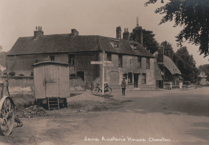CONVICTS themselves were used in the construction of an imposing prison built on barren heathland at Knaphill in the late 1850s.
Here, in a further story about Woking Invalid Convict Prison, later Inkerman Barracks, is the tale of one such prisoner who was transferred there from another prison to provide labour and then serve out the rest of his sentence.
Previously the Peeps page has told the story of ‘Prisoner No.1’ William Stratham. Its third inmate was pickpocket William Privett, from Winchester in Hampshire.
He was born into an average, working-class family in 1835. His father, another William, was an agricultural labourer and his mother had no listed profession, but it’s likely she took in laundry for her neigbours.
William had five siblings, Jane, Elizabeth, Henry, Edward, and Charles. They lived in the Hampshire area for the entirety of their lives, across various parts of county, not moving above, or much below, their status of the “industrious poor”.
William, as the eldest child, may have felt the pressure to help support his father’s growing brood as quickly as possible. It is probable he started working with his father, digging ditches, fixing fences, any labour to increase their meagre income before he had turned the age of 12.
By the time William turned 20 he had perhaps grown sick of the endless drudgery. Perhaps the death of his grandfather aged 51 had soured him. Perhaps insalubrious companions persuaded him – but whatever the cause, he stole a silver pocket watch from Daniel Stockman in October 1855. He was caught and sent to prison remarkably quickly: there he would stay for four years.
William spent time in London’s Millbank Prison first, then Portland in Dorset, and finally transported to Woking to eke out the last few months of his penal servitude helping to build the invalid wings of the prison.
He was released at the end of his sentence in October 1859 and returned home to Hampshire.
William did fairly well for himself for a time. He became a fitter, a skill perhaps acquired in the jail. In addition, he met Eliza Jane Stripe, and they became close, very quickly. Within three months of his return, 18-year-old Eliza found herself pregnant.
William did the right thing by her, although if this was by choice or coercion, we’ll never know. But in May 1860 the pair married in Portsea and awaited the coming of their first child. A son, William, who arrived in October of 1860. He survived just three months.
William and Eliza went on to have a daughter, a girl they named Jane. Jane would later become a seamstress, she would die aged 27, a spinster buried in unconsecrated ground.
But William never knew this as in 1866, aged 31, he died: leaving his three-year-old daughter in the care of his 24-year-old widow.
Thanks again to historians Daniel Shepherd and Gem Minter who have researched and written this story of William Privett as part of their studies into Woking Invalid Convict Prison and the inmates once housed there. They have formed the Institutional History Society, dedicated to exploring England’s institutional system in the 19th century. Its website can be found at www.institutionalhistory.com
If you have some memories or old pictures relating to the Woking area, call me, David Rose, on 01483 838960, or drop a line to the News & Mail.
David Rose is a local historian and writer who specialises in what he calls “the history within living memory” of people, places and events in the west Surrey area covering towns such as Woking and Guildford. He collects old photos and memorabilia relating to the area and the subject, and regularly gives illustrated local history talks to groups and societies. For enquiries and bookings please phone or email him at: [email protected]




